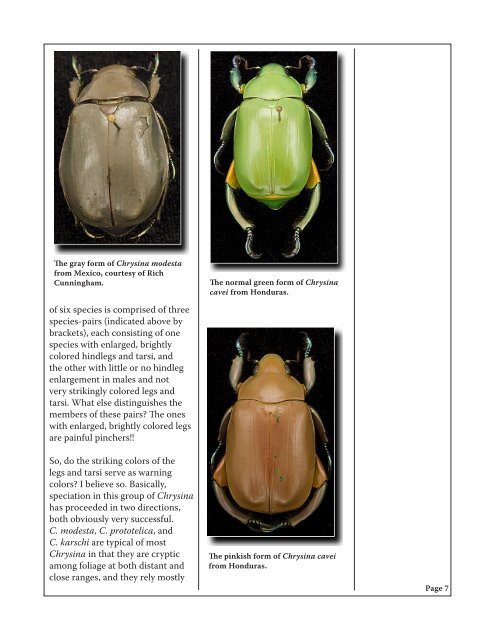SCARABS - University of Nebraska State Museum
SCARABS - University of Nebraska State Museum
SCARABS - University of Nebraska State Museum
Create successful ePaper yourself
Turn your PDF publications into a flip-book with our unique Google optimized e-Paper software.
The gray form <strong>of</strong> Chrysina modesta<br />
from Mexico, courtesy <strong>of</strong> Rich<br />
Cunningham. The normal green form <strong>of</strong> Chrysina<br />
cavei from Honduras.<br />
<strong>of</strong> six species is comprised <strong>of</strong> three<br />
species-pairs (indicated above by<br />
brackets), each consisting <strong>of</strong> one<br />
species with enlarged, brightly<br />
colored hindlegs and tarsi, and<br />
the other with little or no hindleg<br />
enlargement in males and not<br />
very strikingly colored legs and<br />
tarsi. What else distinguishes the<br />
members <strong>of</strong> these pairs? The ones<br />
with enlarged, brightly colored legs<br />
are painful pinchers!!<br />
So, do the striking colors <strong>of</strong> the<br />
legs and tarsi serve as warning<br />
colors? I believe so. Basically,<br />
speciation in this group <strong>of</strong> Chrysina<br />
has proceeded in two directions,<br />
both obviously very successful.<br />
C. modesta, C. prototelica, and<br />
C. karschi are typical <strong>of</strong> most<br />
Chrysina in that they are cryptic<br />
among foliage at both distant and<br />
close ranges, and they rely mostly<br />
The pinkish form <strong>of</strong> Chrysina cavei<br />
from Honduras.<br />
Page 7
















